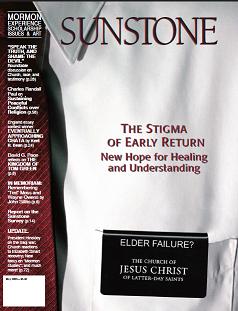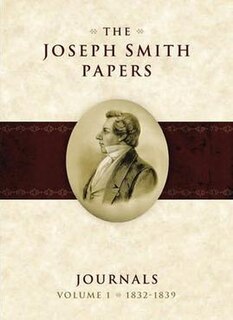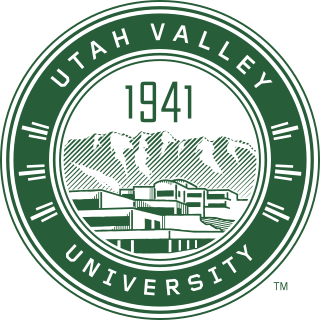 W
WThe Mormon Historic Sites Foundation (MHSF) is an independent organization that seeks to contribute to the memorialization of sites important to the history of The Church of Jesus Christ of Latter-day Saints. The organization also maintains a database of historic sites of the LDS Church called the Mormon Historic Sites Registry.
 W
WSunstone is a magazine published by the Sunstone Education Foundation, Inc., a 501(c)(3) nonprofit corporation, that discusses Mormonism through scholarship, art, short fiction, and poetry. The foundation began the publication in 1974 and considers it a vehicle for free and frank exchange in The Church of Jesus Christ of Latter-day Saints. The magazine's motto is Faith Seeking Understanding.
 W
WAnti-Mormonism is discrimination, persecution, hostility or prejudice directed against the Latter Day Saint movement, particularly The Church of Jesus Christ of Latter-day Saints. The term is often used to describe people or literature that are critical of their adherents, institutions, or beliefs, or physical attacks against specific Saints or the Latter Day Saint movement as a whole.
 W
WAn Insider's View of Mormon Origins is a 2002 book about the origins of Mormonism by Grant H. Palmer, a member of The Church of Jesus Christ of Latter-day Saints who was a Church Educational System instructor and Institute director with a master's degree in history.
 W
WInterpreter: A Journal of Latter-day Saint Faith and Scholarship is a non-profit, peer-reviewed, and educational academic journal published by the Interpreter Foundation covering primarily topics relating to the canon of scriptures of The Church of Jesus Christ of Latter-day Saints, Latter-day Saint apologetics, and Mormon Studies. It was established in 2012 by The Interpreter Foundation with Daniel C. Peterson as founding editor-in-chief. Peterson had previously been the founding editor of the journal FARMS Review, which in 2011 had been renamed Mormon Studies Review and soon thereafter re-launched without apologetics as its main focus. The Interpreter Foundation also sponsors debates and discussions. These have included two symposia focused on the relationship between science and Mormonism. The journal publishes historical surveys, responses to critics, book reviews, personal essays, and other scholarly literature — all with the primary goal of increasing understanding of Latter-day Saint scripture and defending it.
 W
WThe John Whitmer Historical Association (JWHA) is an independent, nonprofit organization promoting study, research, and publishing about the history and culture of the Latter Day Saint movement. It is especially focused on the Community of Christ, other midwestern Restoration traditions, and early Mormonism. The Community of Christ's approach to its own history was influenced, in part, by historical problems raised and explored through JWHA publications and conferences, and those of its sister organization, the Mormon History Association. JWHA membership numbers around 400 and is open to all, fostering cooperation with LDS and non-Mormon scholars.
 W
WThe Joseph Smith Papers is a project researching, collecting, and publishing all manuscripts and documents created by, or under the direction of, Joseph Smith (1805-1844), the founder of the Latter Day Saint movement. The documents, which include transcriptions and annotations, have appeared both online and in printed form. The Church History Department of The Church of Jesus Christ of Latter-day Saints sponsors the project; the department's imprint, the Church Historian's Press, publishes the website and the printed volumes.
 W
WThe Latter Day Saint movement is the collection of independent church groups that trace their origins to a Christian Restorationist movement founded by Joseph Smith in the late 1820s.
 W
WThe Harold B. Lee Library (HBLL) is the main academic library of Brigham Young University (BYU) located in Provo, Utah. The library started as a small collection of books in the president's office in 1876 before moving in 1891. The Heber J. Grant Library building was completed in 1925, and in 1961 the library moved to the newly constructed J. Reuben Clark Library where it stands today. That building was renamed to the Harold B. Lee Library in 1974.
 W
WThe Church History Library (CHL) is a research center and archives building housing materials chronicling the history of The Church of Jesus Christ of Latter-day Saints. The library is owned by the LDS Church and opened in 2009 in downtown Salt Lake City, Utah.
 W
WIn the largest group of the Latter Day Saint movement, The Church of Jesus Christ of Latter-day Saints, folklore is usually distinguished from church doctrine, but there is no universally accepted method of determining where doctrine ends and folklore begins. Most Latter-day Saints consider material in the church's scriptures and joint statements of the First Presidency and Quorum of the Twelve Apostles to constitute church doctrine. Any other part of the expressive cultural aspects of Mormonism may be legitimately classified as Mormon folklore.
 W
WLatter-day Saint Charities is a branch of the welfare department of The Church of Jesus Christ of Latter-day Saints. The organization's stated mission is to relieve suffering, to foster self-reliance for people of all nationalities and religions, and to provide opportunities for service.
 W
WThe Mormon Corridor is the areas of Western North America that were settled between 1850 and approximately 1890 by members of The Church of Jesus Christ of Latter-day Saints, who are commonly nicknamed “Mormons”.
 W
WMormon folklore is a body of expressive culture unique to members of The Church of Jesus Christ of Latter-day Saints and other sects of Mormonism. Mormon folklore includes tales, oral history, popular beliefs, customs, music, jokes, and material culture traditions. In folklore studies, Mormons can be seen as a regional group, since the core group of Mormon settlers in Utah had a common religion and had to modify their surroundings for survival. This historical regional area includes Utah, Southeastern Idaho, parts of Wyoming and eastern Nevada, and a few towns in eastern Arizona, southern Alberta, northwestern New Mexico, southern Colorado, and northern Chihuahua, Mexico.
 W
WThe Latter Day Saint movement is a religious movement within Christianity that arose during the Second Great Awakening in the early 19th century and that led to the set of doctrines, practices, and cultures called Mormonism, and to the existence of numerous Latter Day Saint churches. Its history is characterized by intense controversy and persecution in reaction to some of the movement's doctrines and practices and their relationship to mainstream Christianity. The purpose of this article is to give an overview of the different groups, beliefs, and denominations that began with the influence of Joseph Smith.
 W
WMormonism is the religious tradition and theology of the Latter Day Saint movement of Restorationist Christianity started by Joseph Smith in Western New York in the 1820s and 30s.
 W
WSince the publication of the Book of Mormon in 1830, Mormon archaeologists have attempted to find archaeological evidence to support it. Although historians and archaeologists consider the book to be an anachronistic invention of Joseph Smith, many members of The Church of Jesus Christ of Latter-day Saints and other denominations of the Latter Day Saint movement believe that it describes ancient historical events in the Americas.
 W
WMormon cosmology is the description of the history, evolution, and destiny of the physical and metaphysical universe according to Mormonism, which includes the doctrines taught by leaders and theologians of The Church of Jesus Christ of Latter-day Saints, Mormon fundamentalism, the Restoration Church of Jesus Christ, and other Brighamite denominations within the Latter Day Saint movement. Mormon cosmology draws from Biblical cosmology, but has many unique elements provided by movement founder Joseph Smith. These views are not generally shared by adherents of other Latter Day Saint movement denominations who do not self-identify as "Mormons", such as the Community of Christ.
 W
WThe Mormon religion is predicated on what are said to be historical events such as the First Vision of Joseph Smith and the historicity of the Book of Mormon, which describes a detailed pre-Columbian history of the Americas. Joseph Fielding Smith, the tenth president of The Church of Jesus Christ of Latter-day Saints, declared that "Mormonism, as it is called, must stand or fall on the story of Joseph Smith. He was either a prophet of God, divinely called, properly appointed and commissioned, or he was one of the biggest frauds this world has ever seen. There is no middle ground." As Jan Shipps has written, "Mormonism, unlike other modern religions, is a faith cast in the form of history," and until after World War II, Mormons did not critically examine the historical underpinnings of their faith; any "profane" investigation of the church's history was perceived "as trespassing on forbidden ground."
 W
WAll homosexual or same-sex sexual activity is forbidden by The Church of Jesus Christ of Latter-day Saints in its law of chastity, and the church teaches that God does not approve of same-sex marriage. Adherents who participate in same-sex sexual behavior may face church discipline. Members of the church who experience homosexual attractions, including those who self-identify as gay, lesbian, or bisexual remain in good standing in the church if they abstain from all sexual relations outside an opposite-sex marriage, but all, including individuals participating in same-sex sexual behavior, are allowed to attend weekly church worship services. Additionally, in the church's plan of salvation noncelibate gay and lesbian individuals will not be allowed in the top tier of heaven to receive what's called exaltation to become like God unless they repent, and a heterosexual marriage is a requirement for exaltation.
 W
WMormonism and Nicene Christianity have a complex theological, historical, and sociological relationship. Mormons express the doctrines of Mormonism using standard biblical terminology and have similar views about the nature of Jesus' atonement, bodily resurrection, and Second Coming as traditional Christianity. Nevertheless, most Mormons do not accept the Trinitarian views of orthodox Nicene Christianity, codified in the Nicene and Nicene-Constantinopolitan Creeds of 325 and 381. Although Mormons consider the Protestant Bible as scripture, they do not believe in biblical inerrancy. They have also adopted additional scriptures, including the Book of Mormon, the Doctrine and Covenants, and the Pearl of Great Price. Mormons practice baptism and celebrate the Sacrament, but they also participate in religious rituals not practiced by traditional Christianity. Mormons self-identify as Christian.
 W
WMormonism is the religious tradition and theology of the Latter Day Saint movement of Restorationist Christianity started by Joseph Smith in Western New York in the 1820s and 30s.
 W
WPolygamy was practiced by leaders of The Church of Jesus Christ of Latter-day Saints for more than half of the 19th century, and practiced publicly from 1852 to 1890 by between 20 and 30 percent of Latter-day Saint families. Today, various denominations of fundamentalist Mormonism continue to practice polygamy.
 W
WMissionaries of The Church of Jesus Christ of Latter-day Saints —widely known as Mormon missionaries—are volunteer representatives of the LDS Church who engage variously in proselytizing, church service, humanitarian aid, and community service. Mormon missionaries may serve on a full- or part-time basis, depending on the assignment, and are organized geographically into missions. The mission assignment could be to any one of the 399 missions organized worldwide.
 W
WThe Church of Jesus Christ of Latter-day Saints focuses its doctrine and teaching on Jesus Christ; that he was the Son of God, born of Mary, lived a perfect life, performed miracles, bled from every pore in the Garden of Gethsemane, died on the cross, rose on the third day, appeared again to his disciples, and now resides, authoritatively, on the right hand side of God. In brief, some beliefs are in common with Catholics, Orthodox and Protestant traditions. However, teachings of the LDS Church differ significantly in other ways and encompass a broad set of doctrines, so that the above-mentioned denominations usually place the LDS Church outside the bounds of orthodox Christian teaching as summarized in the Nicene Creed.
 W
WThe Church of Jesus Christ of Latter-day Saints was unofficially established in South Korea as early as World War II due to religious influence by LDS servicemen; however, Korean people did not begin to get baptized until the missionary efforts of LDS servicemen during the Korean War. Kim Ho Jik was the first Korean person to be baptized in the LDS Church on July 29, 1951 in New York. Two of his children were of the first four Korean people baptized in Korea on August 3, 1952. LDS Church presence and missionary work was officially established on April 20, 1956 with the arrival of two missionaries: Don G. Powell and Richard L. Detton. The Korean Mission opened on July 8, 1962 with Gail E. Carr as the first president of the mission. Successful missionary work led to the growth of the LDS Church in the 1960s and 1970s leading to the organization of the first stake in Korea in 1973 and the dedication of the first temple in Seoul on December 14, 1985.
 W
WThe Encyclopedia of Mormonism is a semiofficial encyclopedia for topics relevant to The Church of Jesus Christ of Latter-day Saints. The text is available free online.
 W
WMormonism: A Historical Encyclopedia is an encyclopedia designed for a general readership about topics relating to the History of The Church of Jesus Christ of Latter-day Saints, edited by W. Paul Reeve and Ardis E. Parshall. Reeve is a professor of history at the University of Utah and Parshall is an independent historian, newspaper columnist, and freelance researcher. Most of the encyclopedia's articles were written by historical researchers expert in the specific area covered, while the tone employed is one of objectiveness, yet respect for the beliefs of Mormonism and its culture. It is published by ABC-CLIO, a Santa Barbara, California-based publisher of reference works, as well as of the history journal, Journal of the West.
 W
WMormons are a religious and cultural group related to Mormonism, the principal branch of the Latter Day Saint movement started by Joseph Smith in upstate New York during the 1820s. After Smith's death in 1844 the movement split into several groups following different leaders; the majority followed Brigham Young, while smaller groups followed Joseph Smith III, Sidney Rigdon, and James Strang. Most of these smaller groups eventually coalesced into the Community of Christ, and the term Mormon typically refers to members of The Church of Jesus Christ of Latter-day Saints, as today this branch is far larger than all the others combined. People who identify as Mormons may also be independently religious, secular and non-practicing, or belong to other denominations.
 W
WNew Play Project is a non-profit organization founded in Provo, Utah, by four Brigham Young University students. NPP is dedicated to writing and producing new plays that reflect the standards of a Utah Valley audience. They also aim to give emerging Latter-day Saint writers a place to produce their work while maintaining their standards and values. It primarily produces short play festivals, but occasionally takes on larger projects. It is the first such organization to flourish in the area, and has produced more than 70 original plays since its inception in 2006.
 W
WAn Institute of Religion is a local organization that provides religious education for young adults who are members of The Church of Jesus Christ of Latter-day Saints. Local institutes may function in church meetinghouses, but may also have a stand-alone building situated adjacent to colleges or universities. The LDS Church describes the purpose of the Institute program as "weekday religious instruction for single and married postsecondary students." Institutes of Religion are professionally directed as part of the Church Educational System, with responsibility for the seminary program and the church's higher education institutions, including Brigham Young University (BYU).
 W
WBrigham Young University (BYU) is a private research university sponsored by The Church of Jesus Christ of Latter-day Saints and located in Provo, Utah. The university is accredited by the Northwest Commission on Colleges and Universities. Run under the auspices of the church's parent organization, the Church Educational System (CES), BYU is classified among "R2: Doctoral Universities – High Research Activity" with "more selective, lower transfer-in" admissions. The university's primary emphasis is on undergraduate education in 179 majors, but it also has 62 master's and 26 doctoral degree programs. The university also administers two satellite campuses, one in Jerusalem and one in Salt Lake City.
The Brigham Young University Jerusalem Center for Near Eastern Studies, situated on Mount of Olives in East Jerusalem, is a satellite campus of Brigham Young University (BYU), the largest religious university in the United States. Owned by The Church of Jesus Christ of Latter-day Saints, the center provides a curriculum that focuses on Old and New Testament, ancient and modern Near Eastern studies, and language. Classroom study is built around field trips that cover the Holy Land, and the program is open to qualifying full-time undergraduate students at either BYU, BYU-Idaho, or BYU-Hawaii.
 W
WClaremont Graduate University (CGU) is a private, all-graduate research university in Claremont, California. Founded in 1925, CGU is a member of the Claremont Colleges which includes five undergraduate and two graduate institutions of higher education.
 W
WGraceland University is a private university with campuses in Lamoni, Iowa and Independence, Missouri. The university offers degree completion and master’s degree programs at satellite campuses in Centerville and Cedar Rapids, Iowa, and Trenton, Missouri. It also offers undergraduate and graduate programs online. The university was founded in 1895. Graceland was established by, and is affiliated with, the Community of Christ, formerly the Reorganized Church of Jesus Christ of Latter Day Saints.
 W
WUtah Valley University (UVU) is a public university in Orem, Utah. UVU offers master's, bachelor's, and associate degrees. Previously called Utah Valley State College, the school attained university status in July 2008.